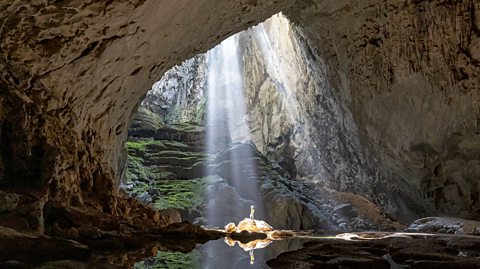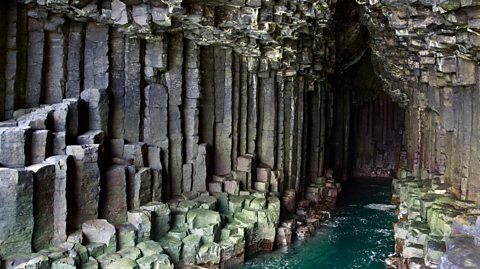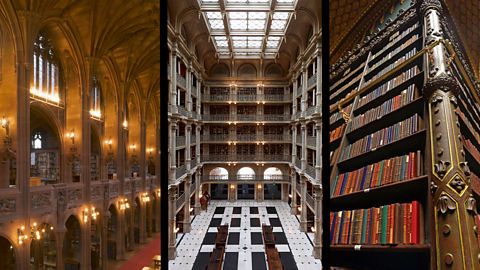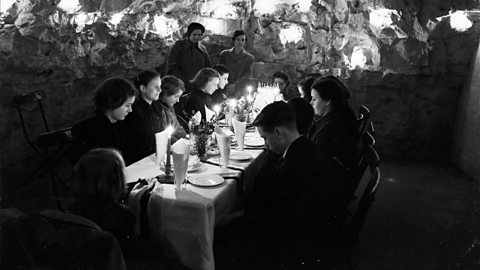
What’s waiting for us within the mysterious depths of a cave? It’s been the stuff of legend and campfire stories for centuries.
Across the world, there are beautiful caverns and subterranean spaces which attract many visitors each year.
While it‚Äôs not a good idea to stroll into a cave on your own (it‚Äôs always best to take a professionally organised tour), once you step over the threshold into these curious places, you can see how magical they are - as 91»»±¨ Bitesize shows.
Waitomo Caves, New Zealand
If caves weren’t exciting enough, in New Zealand they’re illuminated by the wildlife.
The Waitomo Caves are a system of caves south of Auckland on the country’s North Island. They include the Ruakuri Caves, which are home to thousands of glow worms which give the underground world a distinctive light show.
A trip to the Waitomo Caves can include a boat ride which takes visitors directly below the glow worms, which can be seen as dots of light against darkness. It’s best to ‘ooh’ and ‘aah’ inside your head though - they don’t like noise very much.
Quick natural history lesson - glow worms are not really worms. They are beetles.
Both the male and female emit light through a process called bioluminescence, although the females’ light is stronger, to attract males.
Aranui, another cave in the system, is not home to the creatures as they need dark and wet conditions to thrive and there is no water here - although there are large brown, pink and white An icicle-shaped formation that hangs from the ceiling of caves and caverns, formed by the dripping of water. and A formation on the floor of a cave or cavern, created by droplets from the roof. Similar to a stalactite but pointing upwards instead of hanging down. to be found.
Mammoth Cave, USA
One of the oldest tourist attractions in the USA can be found beneath Kentucky soil in the Green River valley.
Mammoth Cave is the longest cave system in the world that we know about. More than 400 miles (643km) of the network have already been explored, and geologists believe there’s hundreds more miles that haven’t been accessed yet.
More than 5,000 years ago, the caves were explored by Native Americans - with the torches that they used to light the way being preserved in some of Mammoth Cave’s drier tunnels.
In the late 1790s, European settlers arrived in the Green Valley where, among other uses, the Mammoth Cave became a mine for saltpeter, a mineral used in gunpowder.
During the War of 1812 between the USA and Great Britain, enslaved workers mined the saltpeter. By 1816, Mammoth Cave was attracting visitors and it was made a National Park in 1941.


Preserved by the USA’s National Park Service, there are 10 miles (16km) of the cave system accessible to the public for tours, with the surrounding area also popular for camping, hiking, fishing and horse-riding. It was named a UNESCO World Heritage site in 1981.
Marble Cathedral, Chile
Patagonia in Chile is perhaps best known in the UK for its Welsh-speaking community, established when 153 pioneers from Wales travelled to South America in 1865 to form a corner of their homeland in another part of the world. Y Wladfa, the community they built, is still there today.
What may be less well-known is that Patagonia is home to a beautiful cave known as the marble cathedral.

Lago General Carrera (also known as General Carrera Lake or Lake Buenos Aires) is a vast stretch of water that crosses the Chilean border into Argentina. The lake is a distinctive shade of turquoise due to glacial silt - produced by ground up rock particles that are released when a glacier erodes. It’s also the lake where the marble caves can be found.
Anyone visiting the caves can see streaks of white, brown and yellow along its walls - the white being a pure form of marble. When the blue lake waters ripple and reflect on the walls, the effect has become a popular one for tourist photos.
Hang son Doong, Vietnam
Keen viewers of David Attenborough’s Planet Earth III documentary series may remember Hang son Doong, believed to be the largest cave on the planet.

Found near the border of Laos and Vietnam, the interior of Hang son Doong is so vast, it is said that it could house several 40-storey skyscrapers quite comfortably.
Size is something Hang son Doong has in spades. The stalagmites can reach up to 80m (262ft) in height.
For a short period each year - around two weeks in March - the area 200m (656ft) below ground is illuminated by sunbeams that come through a hole in the cave roof and allows some vegetation to grow. In summer, it is possible to see mists and clouds form inside the cave.
Fingal’s Cave, UK
The novelist Sir Walter Scott said of Fingal’s Cave: “The most extraordinary place I ever beheld; it baffles all description.”
The hexagonal A dark volcanic rock. columns found in this sea cave within the island of Staffa, Scotland, were created by the slow cooling of molten lava, which would have erupted there centuries ago. Similar to the Giants Causeway in Northern Ireland, cooling molten rock often results in these geometric columns, though as some scientists suggest, when this phenomenon happens in water (as Fingal’s Cave and the Causeway have in common), cooling is sped up and makes the formations more distinctive.

Staffa can only be accessed by boat and is popular with tourists, who not only visit the cave, but also watch the island’s puffins going about their daily business. There is a handful of stories about which particular Fingal from history gave the cave its name. One is that he was the hero of an 18th Century poem, another is that Fingal was a giant who placed Staffa in the sea as a stepping stone in their path to Ireland.
Either way, Fingal’s Cave has impressed many visitors, including the composer Felix Mendelssohn, who visited in 1829 and later wrote an overture bearing its name. That is, once his seasickness from the boat ride wore off.
This article was published in October 2024
What is Britain made of?
Test your geological knowledge of the UK in our quiz

Six beautiful libraries from around the world
From life-like wooden carvings to rom-com film settings, join 91»»±¨ Bitesize as we explore six magnificent libraries from around the world.

The hidden worlds beneath the UK's feet
Spooky vaults, unseen rivers and caves which sheltered thousands from the Blitz
